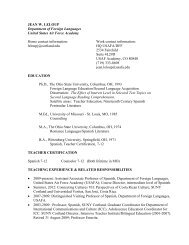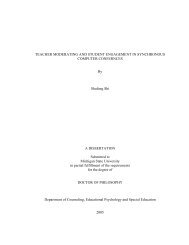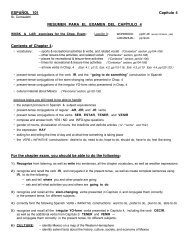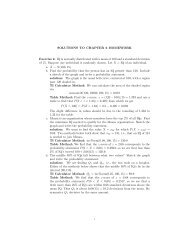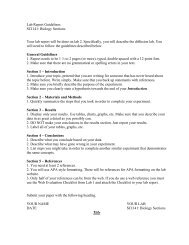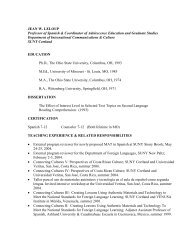Iterated Function Systems and Fractals - SUNY Cortland
Iterated Function Systems and Fractals - SUNY Cortland
Iterated Function Systems and Fractals - SUNY Cortland
You also want an ePaper? Increase the reach of your titles
YUMPU automatically turns print PDFs into web optimized ePapers that Google loves.
<strong>Iterated</strong> <strong>Function</strong> <strong>Systems</strong> <strong>and</strong> <strong>Fractals</strong><br />
by<br />
Isa S. Jubran<br />
<strong>SUNY</strong> College at Cortl<strong>and</strong><br />
Abstract: The study of fractals arising as attractors of IFS’s became an<br />
area of practical importance thanks to M<strong>and</strong>elbrot’s fundamental insight<br />
that many natural objects have some self similarity <strong>and</strong> Barnsley’s insight<br />
that it is possible to begin with a shape <strong>and</strong> determine an IFS whose<br />
attractor converges onto that shape . A number of artificial as well as<br />
natural fractals <strong>and</strong> their possible IFS’s will be investigated using java<br />
applets that are freely available on the Web.
Affine transformations:<br />
An affine transformation is of the form<br />
⎛<br />
f(<br />
x ⎝<br />
y<br />
⎞ ⎛<br />
⎠) =<br />
⎝ a<br />
b<br />
c d<br />
⎞<br />
or<br />
⎠ ·<br />
⎛<br />
⎝ x y<br />
⎞ ⎛<br />
⎠ +<br />
⎝ e f<br />
⎞<br />
⎠<br />
⎛<br />
f(<br />
x ⎝<br />
y<br />
⎞ ⎛<br />
⎠) = ⎝<br />
r cos(θ) −s sin(φ)<br />
r sin(θ) s cos(φ)<br />
⎞<br />
⎠ ·<br />
⎛<br />
⎝ x y<br />
⎞ ⎛<br />
⎠ +<br />
⎝ e f<br />
⎞<br />
⎠<br />
• r <strong>and</strong> s are the scaling factors in the x <strong>and</strong> y directions resp.<br />
• θ <strong>and</strong> φ measure rotation of horizontal <strong>and</strong> vertical lines resp.<br />
• e <strong>and</strong> f measure horizontal <strong>and</strong> vertical translations resp.<br />
It can be easily shown that:<br />
• r 2 = a 2 + c 2 ,<br />
• s 2 = b 2 + d 2 ,<br />
• θ = arctan(c/a), <strong>and</strong><br />
• φ = arctan(−b/d).<br />
✻<br />
b<br />
✻<br />
✛<br />
θ<br />
a<br />
c<br />
✲<br />
✛<br />
d<br />
φ<br />
✲<br />
❄<br />
❄<br />
2
For example, shears are represented as follows:<br />
B ′ A ′<br />
✻<br />
.....................<br />
.....................<br />
✻<br />
.....................<br />
.....................<br />
..................... B<br />
..................... B C<br />
C<br />
C<br />
..................... .....................<br />
✲<br />
..................... .....................<br />
′<br />
✲<br />
D<br />
A<br />
D<br />
A<br />
x ′ = x<br />
y ′ = 2x + y<br />
Shear in the y direction<br />
x ′ = x + 2y<br />
y ′ = y<br />
Shear in the x direction<br />
B ′<br />
⎛<br />
a ⎝<br />
b<br />
c d<br />
⎞<br />
⎠ =<br />
⎛<br />
⎝ 1 0<br />
2 1<br />
⎞<br />
⎠<br />
⎛<br />
a ⎝<br />
b<br />
c d<br />
⎞<br />
⎠ =<br />
⎛<br />
⎝ 1 2<br />
0 1<br />
⎞<br />
⎠<br />
r = √ 5, s = 1 r = 1, s = √ 5<br />
θ = 63.435, φ = 0 θ = 0, φ = −63.435<br />
3
Finding IFS Rules from Images of Points<br />
Given three non-collinear initial points p 1 = (x 1 , y 1 ), p 2 = (x 2 , y 2 ), p 3 =<br />
(x 3 , y 3 ) <strong>and</strong> three image points q 1 = (u 1 , v 1 ), q 2 = (u 2 , v 2 ), q 3 = (u 3 , v 3 ) respectively.<br />
Find an affine transformation T such that T (p 1 ) = q 1 , T (p 2 ) =<br />
q 2 , <strong>and</strong> T (p 3 ) = q 3 .<br />
Recall that,<br />
⎛<br />
T (<br />
x ⎝<br />
y<br />
⎞ ⎛<br />
⎠) =<br />
⎝ a<br />
b<br />
c d<br />
⎞ ⎛<br />
⎠ ·<br />
⎝ x y<br />
⎞ ⎛<br />
⎠ +<br />
⎝ e f<br />
⎞<br />
⎠<br />
Now Using p 1 , p 2 , p 3 <strong>and</strong> their images we arrive at the following six equations<br />
in six unknowns:<br />
ax 1 + by 1 + e = u 1<br />
cx 1 + dy 1 + f = v 1<br />
ax 2 + by 2 + e = u 2<br />
cx 2 + dy 2 + f = v 2<br />
ax 3 + by 3 + e = u 3<br />
cx 3 + dy 3 + f = v 3<br />
This system has a unique solution if <strong>and</strong> only if the points p 1 , p 2 , <strong>and</strong> p 3<br />
are noncollinear.<br />
4
Example: The Seirpinski Triangle<br />
1 .....................<br />
.........................................<br />
.........................................<br />
.5, 0, 0, .5, .........................................<br />
0, .5<br />
.....................<br />
.....................<br />
.....................<br />
.....................<br />
.........................................<br />
.........................................<br />
.5, 0, 0, .5, .5, 0<br />
.........................................<br />
.........................................<br />
.....................<br />
0<br />
.5, 0, 0, .5, 0, 0<br />
1<br />
The IFS for the Seirpinski triangle is {T 1 , T 2 , T 2 } where<br />
⎛<br />
T 1 (<br />
x ⎝<br />
y<br />
⎛<br />
T 2 (<br />
x ⎝<br />
y<br />
⎛<br />
T 3 (<br />
x ⎝<br />
y<br />
⎞ ⎛<br />
⎠) =<br />
.5 0 ⎝<br />
0 .5<br />
⎞ ⎛<br />
⎠) =<br />
.5 0 ⎝<br />
0 .5<br />
⎞ ⎛<br />
⎠) =<br />
.5 0 ⎝<br />
0 .5<br />
⎞<br />
⎠ ·<br />
⎞<br />
⎠ ·<br />
⎞<br />
⎠ ·<br />
⎛<br />
⎝ x y<br />
⎛<br />
⎝ x y<br />
⎛<br />
⎝ x y<br />
⎞<br />
⎠ +<br />
⎞<br />
⎠ +<br />
⎞<br />
⎠ +<br />
⎛<br />
⎝ 0 0<br />
⎛<br />
⎝ .5 0<br />
⎛<br />
⎝ 0<br />
.5<br />
⎞<br />
⎠<br />
⎞<br />
⎠<br />
⎞<br />
⎠<br />
http://smccd.net/accounts/hasson/fract.html<br />
5
Example: The Seirpinski Carpet<br />
2<br />
3<br />
1<br />
3<br />
✻<br />
1 . . V I V II V III<br />
.....................<br />
.....................<br />
.....................<br />
IV<br />
V<br />
.....................<br />
.....................<br />
.....................<br />
I II III<br />
0 .....................<br />
.....................<br />
.....................<br />
0<br />
1<br />
1<br />
3<br />
2<br />
3<br />
✲<br />
The IFS for the Seirpinski carpet is {T 1 , T 2 , T 3 , T 4 , T 5 , T 6 , T 7 , T 8 } where<br />
⎛<br />
T 1 (<br />
x ⎝<br />
y<br />
⎛<br />
T 2 (<br />
x ⎝<br />
y<br />
⎛<br />
T 3 (<br />
x ⎝<br />
y<br />
⎛<br />
T 4 (<br />
x ⎝<br />
y<br />
⎛<br />
T 5 (<br />
x ⎝<br />
y<br />
⎛<br />
T 6 (<br />
x ⎝<br />
y<br />
⎛<br />
T 7 (<br />
x ⎝<br />
y<br />
⎛<br />
T 8 (<br />
x ⎝<br />
y<br />
⎞ ⎛<br />
⎠) =<br />
.333 0<br />
⎝<br />
0 .333<br />
⎞ ⎛<br />
⎠) =<br />
..333 0<br />
⎝<br />
0 .333<br />
⎞ ⎛<br />
⎠) =<br />
.333 0<br />
⎝<br />
0 .333<br />
⎞ ⎛<br />
⎠) =<br />
.333 0<br />
⎝<br />
0 .333<br />
⎞ ⎛<br />
⎠) =<br />
.333 0<br />
⎝<br />
0 .333<br />
⎞ ⎛<br />
⎠) =<br />
.333 0<br />
⎝<br />
0 .333<br />
⎞ ⎛<br />
⎠) =<br />
.333 0<br />
⎝<br />
0 .333<br />
⎞ ⎛<br />
⎠) =<br />
.333 0<br />
⎝<br />
0 .333<br />
⎞<br />
⎞<br />
⎠ ·<br />
⎠ ·<br />
⎞<br />
⎠ ·<br />
⎞<br />
⎠ ·<br />
⎞<br />
⎠ ·<br />
⎞<br />
⎠ ·<br />
⎞<br />
⎠ ·<br />
⎞<br />
⎠ ·<br />
⎛<br />
⎛<br />
⎝ x y<br />
⎝ x y<br />
⎛<br />
⎝ x y<br />
⎛<br />
⎝ x y<br />
⎛<br />
⎝ x y<br />
⎛<br />
⎝ x y<br />
⎛<br />
⎝ x y<br />
⎛<br />
⎝ x y<br />
⎞<br />
⎞<br />
⎠ +<br />
⎠ +<br />
⎞<br />
⎠ +<br />
⎞<br />
⎛<br />
⎛<br />
⎝ 0 0<br />
⎞<br />
⎠<br />
⎝ .333 0<br />
⎛<br />
⎠ + ⎝<br />
⎞<br />
⎠ +<br />
⎞<br />
⎝ .666 0<br />
⎛<br />
⎛<br />
⎠ + ⎝<br />
⎞<br />
⎠ +<br />
⎞<br />
⎠ +<br />
0<br />
.333<br />
⎝ .666<br />
.333<br />
⎛<br />
⎛<br />
0<br />
.666<br />
⎝ .333<br />
.666<br />
⎛<br />
⎝ .666<br />
.666<br />
⎞<br />
⎠<br />
⎞<br />
⎠<br />
⎞<br />
⎠<br />
⎞<br />
⎠<br />
⎞<br />
⎠<br />
⎞<br />
⎠<br />
⎞<br />
⎠<br />
6
Example: A simple tree<br />
✻<br />
........... (5,...........<br />
20)<br />
...........<br />
...........<br />
(15, ...........<br />
20)<br />
...........<br />
.<br />
.5, −.5, .5, .5, . 5, 5<br />
...........<br />
.<br />
...........<br />
. . .5, .5, −.5, . .5, 5, 15<br />
(5, 15) (15, 15)<br />
(0, 15)<br />
........... ...........<br />
...........<br />
...........<br />
...........<br />
...........<br />
.<br />
(20, 15)<br />
.<br />
...........<br />
.<br />
...........<br />
. . .<br />
........... ...........<br />
...........<br />
...........<br />
...........<br />
...........<br />
.<br />
(10, 10)<br />
.<br />
...........<br />
.<br />
...........<br />
. . . −10 < x < 30<br />
0 < y < 40<br />
........... ...........<br />
...........<br />
...........<br />
...........<br />
...........<br />
.<br />
.<br />
...........<br />
.<br />
...........<br />
. . .<br />
T runk 0, 0, 0, .333, 10, 0<br />
........... ...................<br />
...................... ..........<br />
........... ..........<br />
✲<br />
(10, 0)<br />
The IFS for the tree is {T 1 , T 2 , T 2 } where<br />
⎛<br />
T 1 (<br />
x ⎝<br />
y<br />
⎛<br />
T 2 (<br />
x ⎝<br />
y<br />
⎛<br />
T 3 (<br />
x ⎝<br />
y<br />
⎞ ⎛<br />
⎠) = ⎝<br />
⎞ ⎛<br />
⎠) = ⎝<br />
.5 .5<br />
−.5 .5<br />
.5 −.5<br />
.5 .5<br />
⎞ ⎛<br />
⎠) =<br />
0 0<br />
⎝<br />
0 .333<br />
⎞<br />
⎠ ·<br />
⎞<br />
⎠ ·<br />
⎞<br />
⎠ ·<br />
⎛<br />
⎝ x y<br />
⎛<br />
⎝ x y<br />
⎛<br />
⎝ x y<br />
⎞<br />
⎠ +<br />
⎞<br />
⎠ +<br />
⎞<br />
⎠ +<br />
⎛<br />
⎝ 5<br />
15<br />
⎛<br />
⎝ 5 5<br />
⎛<br />
⎝ 10 0<br />
⎞<br />
⎠<br />
⎞<br />
⎠<br />
⎞<br />
⎠<br />
http://alumnus.caltech.edu/ chamness/equation/equation.html<br />
http://smccd.net/accounts/hasson/fract.html<br />
7
Demonstrate some of the java applets at<br />
http://classes.yale.edu/fractals/Software/Software.html<br />
Discuss the IFS for the Fern.<br />
Discuss the IFS for the mountain range.<br />
Discuss the IFS for the Wave.<br />
8
<strong>Iterated</strong> <strong>Function</strong> <strong>Systems</strong>:<br />
An <strong>Iterated</strong> <strong>Function</strong> System in R 2 is a collection {F 1 , F 2 , . . . , F N } of contraction<br />
mappings on R 2 . (F i is a contraction mapping if given x, y then<br />
d(F i (x), F i (y)) ≤ s d(x, y) where 0 ≤ s < 1)<br />
The Collage Theorem says that there is a unique nonempty compact<br />
subset A ⊂ R 2 called the attractor such that<br />
A = F 1 (A) ∪ F 2 (A) ∪ . . . ∪ F N (A)<br />
Sketch of Proof:<br />
Given a complete metric space X, let H(X) be the collection of nonempty<br />
compact subsets of X. Given A <strong>and</strong> B in H(X) define d(A, B) to be the<br />
smallest number r such that each point of in A is within r of some point<br />
in B <strong>and</strong> vice versa. If X is complete so is H(X).<br />
A = [0, 3]<br />
B = [2, 4]<br />
2 3 4<br />
0 1 2 3<br />
d(A, B) = 2<br />
Given an IFS on X, define G : H(X) → H(X) by<br />
G(K) = F 1 (K) ∪ . . . ∪ F N (K)<br />
If each F i is a contraction then so is G. The contraction mapping theorem<br />
says that a contraction mapping on a complete space has a unique fixed<br />
point. Hence there is A ∈ H(X) such that<br />
G(A) = A = F 1 (A) ∪ F 2 (A) ∪ . . . ∪ F N (A)<br />
Given K 0 ⊂ R 2 , let K n = G n (K 0 ). Then<br />
d(A, K n ) ≤ sn d(K 0 , G(K 0 ))<br />
1 − s<br />
Hence K n is a very good approximation of A for large enough n.<br />
9
To underst<strong>and</strong> the previous result note that:<br />
d(A, K 0 ) = d( n→∞<br />
lim K n , K 0 )<br />
= n→∞<br />
lim d(K n , K 0 )<br />
≤ n→∞<br />
lim d(K 0 , K 1 ) + d(K 1 , K 2 ) + · · · + d(K n−1 , K n )<br />
≤ n→∞<br />
lim d(K 0 , K 1 ) + sd(K 0 , K 1 ) + · · · + s n−1 d(K 0 , K 1 )<br />
1<br />
≤<br />
1 − s d(K 0, K 1 )<br />
Hence,<br />
d(A, K 1 ) ≤ 1<br />
1 − s d(K 1, K 2 ) ≤ s<br />
1 − s d(K 0, K 1 )<br />
d(A, K 2 ) ≤ 1<br />
1 − s d(K 2, K 3 ) ≤ s2<br />
1 − s d(K 0, K 1 )<br />
.<br />
Deterministic Algorithm: (Slow!)<br />
Given K 0 , let K n = G n (K 0 ). Now K n → A <strong>and</strong> n → ∞.<br />
R<strong>and</strong>om Algorithm: (Fast!)<br />
Given Q 0 ∈ K 0 , let Q i+1 = F j (Q i ) where F j is chosen with probability<br />
p j from all of the F i . Clearly Q i ∈ K i <strong>and</strong> for sufficiently large i, Q i is<br />
arbitrarily close to some point in A.<br />
Choose p i ∼ |detA i|<br />
N∑<br />
|detA i |<br />
i=1<br />
= |a id i − b i c i |<br />
N∑<br />
|a i d i − b i c i |<br />
i=1<br />
Geometrically, choose p i “proportional to F i .”<br />
.<br />
10
How do these algorithms work:<br />
3 33<br />
3 21<br />
3 22<br />
3 31<br />
3 32<br />
3 13<br />
3 23<br />
3 11<br />
3 12<br />
1 33<br />
11<br />
2 33<br />
1 31<br />
1 32<br />
2 31<br />
2 32<br />
1 13<br />
1 21<br />
1 2<br />
2 11<br />
2 12<br />
1 23<br />
2 13<br />
2 23<br />
1 11<br />
1 12<br />
2<br />
2 21<br />
2 22



